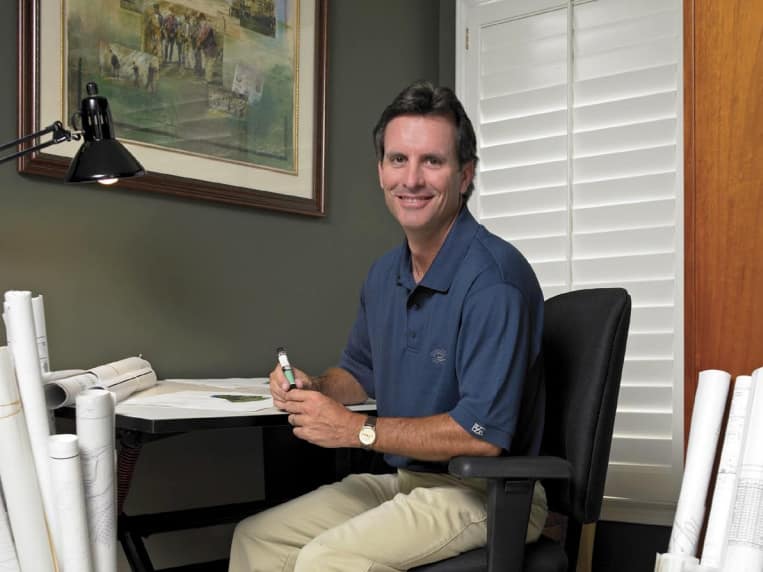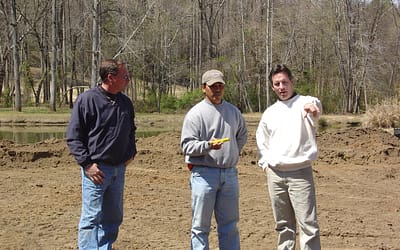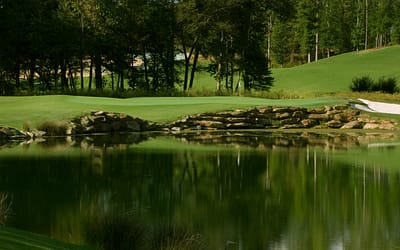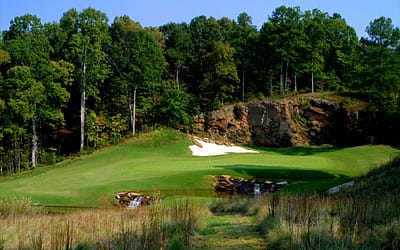Riley’s interpretive approach to course design and bold architecture provides a refreshing take on a classical aesthetic.
View the original article in PDF format.
By Jeff Lam, AVID GOLFER
Watching the 2006 U.S. Open at historic Winged Foot Golf Club earlier this summer, Michael Riley was not focused on the play of Phil Mickelson, Colin Montgomerie and Geoff Ogilvy down the stretch. Rather, Riley was much more intrigued by the widths of the fairways, the placement of the tees and the contours of the greens.
See, ever since he was a teenager caddying at Somerset Hills Country Club in Bernardsville, N.J., Riley has been fascinated with the design and strategy of golf courses. Most youngsters walking the course with him probably had no idea who was behind the course design, but Riley was well aware that Somerset Hills was an A.W. Tillinghast work. His love for golf and landscaping and knowledge of great course designers, coupled by the fact that Robert Trent Jones, Sr., had an office nearby, beckoned Riley to chase a career in golf course architecture at an early age.
Recalling his days as a caddy for the “old money” members at the exclusive Somerset Hills, including the likes of Frank Hannigan, Riley remembered the bold contours and great holes created in a beautiful setting. It was walking through this daily setting that he developed a real passion for the game, thus cementing his want to build his own courses in such a natural setting someday.
Pursuing this desire, he enrolled at Clemson University and majored in horticulture to further develop his interest and knowledge. While there, Riley landed a summer job in the pro shop at Saint Andrews Golf Club, located in Hastings-on-Hudson, N.Y. Self-proclaimed as the oldest golf club in America – founded in 1888 – Saint Andrews was a founding member of the USGA. Aside from the history and tradition of the club that made it appealing, a relatively new company was close by: the Nicklaus organization, which had been hired to redesign the course.
Working at Saint Andrews gave Riley the opportunity to meet Nicklaus and various people in the Golden Bear’s budding course design business. After a few years of working in New York in the summer and Florida in the winter, and a short stint on the mini tours, a position opened up with Nicklaus’ organization, so Riley quit playing competitively to become a site coordinator in Tucson, Ariz.
As a site coordinator, Riley worked closely with Nicklaus, who spent a lot of time out in the field, surveying his courses firsthand. Soon, Riley was promoted to designer and was handling courses in California, Hawaii, Japan, Guam and Canada. Working next to arguably the greatest player in the history of the game and one of the premiere course designers, Riley had hours of Nicklaus’ undivided attention each day as they surveyed courses under construction.
Like Nicklaus, Riley likes to be in charge of all that goes on in the field to make sure his standards and specifications are met.
“Everything you see [on a Nicklaus course] is Jack Nicklaus,” said Riley, who strives to hold the same philosophy. “Seeing how he did it in the field really helped my progression, from learning how to set up strategy, bunker placement, green slopes and contours.”
It was also during this time that he developed his golf game. While caddying at Somerset Hills as a boy, his play was limited to Mondays when the course was closed. It was only during his junior year in high school that Riley began to play regularly. And it was not until after he graduated from Clemson that his golf game matured.
“I was a late bloomer,” Riley said. “I got better after college when I could play every day. My game really took off when I moved to Atlanta and was able to start playing in the Georgia State Golf Association events.”
Riley is being humble, to say the least. He has twice qualified for the U.S. Mid-Amateur and even captured the prestigious Anderson Memorial at the aforementioned Winged Foot in 1994. Although he calls himself more of a “recreational golfer” now (a 3-year-old son keeps him off the course), he can still keep it around par or better on a good day.
Following his seven-year stint with the Nicklaus organization, Riley went to work with another renowned designer and Nicklaus protégé, Bob Cupp. Working for Cupp brought Riley to the Atlanta area, a region full of very interesting land on which to build challenging golf courses. He worked under Cupp for two years before going solo and becoming president of Michael Riley Design.
Riley cites the rolling terrain, the abundance of creeks and numerous pine tree and hardwoods among the natural features that make the land so amenable to creating good golf holes. It is these “natural features of property” that Riley likes to use when designing golf courses.
However, these same things he loves to make use of can also be a hindrance at times. For example, he says the terrain can sometimes contain too much slope and contour to create a perfect, ideal golf course.
In addition, the variety of creeks and other natural features have to be looked at with environmental considerations in mind.
Finally, there is usually the equation of real estate development to factor in.
“From a housing development standpoint, it makes things more challenging in routing the course to take advantage of the natural features,” he said.
Sometimes, Riley might not even be able to use a feature because a clubhouse or road or home location prohibits its use.
“After everything else is established, you find what you have to work with,” he said.
Because of these considerations and tougher environmental restrictions, Riley added, “Sometimes it is easier if you have a flat piece of property with no trees and no water, because we can create everything ourselves in such a fashion that people can’t tell it was created by man. But you can’t beat a course created in a natural setting.”
One aspect of course designs on which Riley focuses is bunker placement. After pointing out that all the top courses and great sites have dramatic and distinctive bunkering, a facet that gives the golf course the most character, Riley said he spends “a lot of time on bunker lines and bunker placement [in his designs] to give the golf
course aesthetic appeal and character.”
In fact, out of all the courses on which Riley has worked, the feature he likes the most and uses time and time again revolves around bunkering. He loves placing short bunkers on par 3s between the tees and green that do not really come into play but
still perform a role in the hole.
“People usually don’t hit into them,” he said, “but they affect shots [i.e., depth perception] and add to the composition of the hole.”
Another feature he deals a lot with is the contours of the greens, an aspect he must be very careful with depending on the speed of the greens with which he works. The project he currently is working on is a redesign of Rivermont Golf Club in Alpharetta, where the green speed will be managed to handle the bold contours of the greens.
When designing courses, Riley does not have a trademark or signature feature he uses for every course. Instead, he designs each one in its own unique way, because he attempts to have variety among his holes and make them memorable for everyone who plays them. Seeking to avoid creating a nondescript golf course that no one will remember when they retire to the 19th hole to discuss their rounds, Riley makes sure things are constantly changing on his courses and ensures there is no repetition.
Riley works hard to make sure his courses are challenging both strategically and visually. He thrives on giving every golfer, no matter what skill level they are, different options on every hole so that they can enjoy his courses day in and day out.
Designing his holes accordingly, Riley emphasizes course management, which he believes to be an important aspect of the game. In doing so, he forces players to manage their game instead of just
swinging away.
“I try to make [my courses] challenging and enjoyable for all levels of play,” he said. “That’s a difficult thing to do.”
However hard it might be to create a course for both low and high handicappers, Riley insists, “There’s a way to play [his holes] for all levels of golfers.”
In addition to the project at Rivermont, Riley is currently working on a bunker renovation at Crooked Creek Golf Club, also in Alpharetta. Those two projects occupy all of his time because they require his utmost devotion. Riley likes to be hands-on with all his projects, just like his mentor, Jack Nicklaus, so he is on site, clearing to grassing every day. He deals with all the little nuances, from how the dirt is moved to how the bunkers are shaped firsthand. Everything you see on a Michael Riley-designed course is Michael Riley.
Once his current projects are complete, Riley doesn’t intend to stay quiet for too long.
“I hope to continue to build [great golf courses] in Atlanta,” he said, “an area that has seen a great growth in golf since I arrived [in the early 1990s].”
Thanks to Michael Riley, golfers in the Atlanta area will continue to have easy access to great golf courses such as those he has already designed, which include Reunion Golf Club in Hoschton – voted Best New Course in Georgia in 2001 by Georgia Golf News – as well as Governors Towne Club in Acworth.
In the Bag
Age: 47
Occupation: President, Michael Riley Design, LLC
In the bag: Titleist 905R driver; Callaway X-14 pro series irons; Bridgestone 3 wood; Vokey wedges; and TP Mills putter.
Favorite club: 8-iron.
Least favorite club: 3-wood.
Handicap: Scratch
Favorite course in Atlanta: Peachtree Golf Club
Wish list: Pine Valley Golf Club; Augusta National, Chicago Golf Club; anything by Charles Blair Macdonald, Seth Raynor, or Bill Coore and Ben Crenshaw.
Jeff Lam is a Florida-based, award-winning freelance writer.
In the same category





